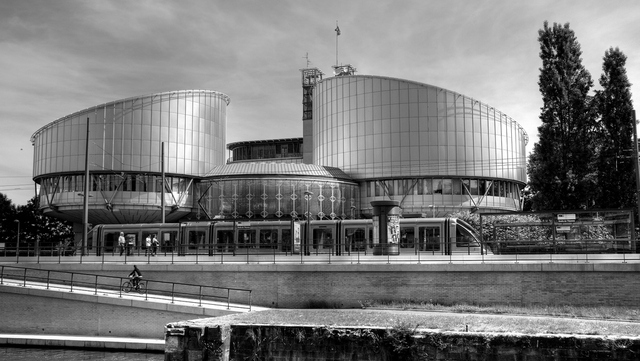Human rights protection in Europe evolved significantly over the last century, culminating in the creation of the European Court of Human Rights. Unfortunately, the decisions made by the European Court of Human Rights are not binding and do not serve as precedent for future cases. The court has the potential to hold significantly greater influence over human rights protection, but its institutional structure and guiding doctrine (the European Convention on Human Rights) does not allow for this. Although the Court maintains jurisdiction over a smaller number of states, it has a more significant influence over human rights protection than other courts, including the European Court of Justice, the International Court of Justice, and the International Criminal Court. This paper compares the roles that each court plays in human rights protection.
The historical evolution of human rights in Europe is essential to understanding the status ofthe region's unique legal structure and why human rights protection is a critical area of focus.
The main supranational legal institutions in Europe are the European Court of Human Rights and the European Court of Justice. Each court maintains separate jurisdictions within Europe: the European Court of Human Rights oversees the 47 members of the Council of Europe, while the European Court of Justice oversees the 27 member states of the European Union.
The courts vary in their respective methods of addressing rights and appealing cases. Historically, the European Court of Human Rights has been more accessible to individuals and thus offers a more valuable protection of rights to citizens, and is "…the most effective supervisory machine for human rights in Europe." Although there are many legal institutions that play important roles in the European legal system, there have been insufficient studies conducted on the effectiveness of the legal implementation and enforcement of human rights law in Europe.

Part of the building of the the European Court of Human Rights in Strasbourg, France. Photo: James Russell SA-2
Legal historian Lawrence Friedman also indicates that there have been insufficient studies conducted about the future of the legal culture in Europe, although there have been studies on the legal culture's impact on domestic legal systems, legal methodologies, and structural aspect of the courts.
The European Court of Human Rights has had the greatest impact on defending and protecting human rights, but it has not been recognized with due credit for its pioneering achievements.
As this analysis illustrates, the European Court of Human Rights has had the greatest impact on defending and protecting human rights, but it has not been recognized with due credit for its pioneering achievements. Therefore, the focus of this paper is on the history of the courts and comparisons of case outcomes of mainly the European Court of Human Rights, and to a lesser extent the European Court of Justice. It leads to an analysis of the historical background of these legal institutions that have jurisdiction in Europe, their respective jurisdictions, examples of cases from each court, and an analysis of their unique features.
Given the nature and scope of this paper, the materials used and applied for research focus mainly on an institutional history of the courts, case outcomes, governing doctrines of legal institutions (such as the European Convention on Human Rights and the Universal Declaration on Human Rights), as well as legal opinions and legal trends.
Other international courts that have jurisdiction in Europe are the International Criminal Court (ICC) and the International Court of Justice (ICJ), each overseeing a larger jurisdiction (quantitatively) and are comprised of more member states than the European Court of Human Rights. The ICC, ICJ, and European Court of Justice are also limited in their scope to hearing complaints by states, and do not allow an individual person to petition cases to the court. The European Court of Human Rights, however, allows any individual to appeal his or her case, and therefore covers a much wider range of issues and consequently number of people.
This distinction is important in the realm of human rights protection, as it is unique to selective courts in Europe. This factor is not only relevant with regard to the quantity (111 member states) but also in range and scope of concerned issues. Thus, it is more inclusive and therefore conducive to a deeper examination and analysis of the facts. The limited scopes of the ICC, ICJ, and European Court of Justice eliminates many potentially valid complaints and concerns of individuals that would otherwise hold a valid claim to an appeal, as only a petitioners appealing as a member of a party of a state can have their case considered for appeal. To better examine and provide an overview of the court system, the four main courts will be discussed to evaluate the effectiveness of the European Court of Human Rights.
Historically, the urgency for a supranational court arose after the Second World War. Following the atrocities of the Holocaust, a permanent international court was necessary for future cases after the Nuremberg trials were held in a specially created court. Prior to this, no permanent international world court had been established. The creation of the court at an international level was unprecedented and revolutionary: the emergence of such an influential institution is rare.
As the United States Supreme Court record details, the crimes tried in Nuremberg ranged from using members of the concentration camps for sterilization testing, experimentation with freezing techniques, mutilation experiments, exposure to poison gas, and other fatal tests. The defendants (Nazi party officials) were also charged with war crimes and crimes against humanity through the mistreatment of civilians, torture of prisoners, and murder through an attempted eradication of minority populations (including but not limited to those of Jewish descent, Romani descent, Polish descent, disabled persons, homosexuals, and political opponents).,
Although it took many years after the Nuremburg trials to establish the International Criminal Court, the precedent set by the trials was critical in serving as the foundation for a permanent world court. Ratified by 111 member states in July of 2002, the Rome Statute conferred the ICC with the jurisdiction to span across the European continent with a focus on the prevention of the atrocities of war crimes and crimes against humanity. The issues covered by the ICC are separated into four categories: crimes against humanity, war crimes, crimes of aggression, and genocide. Although the ICC holds a greater number of states under its jurisdiction, there are limited means to bring a case to "court of last resort."
The only permissible criteria are by being a member of a national state party, having a crime committed in a country that is party to the Rome Statute, or if the matter has been referred to the court by the United Nations Security Council. This severely limits the number of cases that can be brought before the Court. The ICC does not have any authority to review grievances from an individual's claim: if a case falls outside the scope of the aforementioned qualifications, the case cannot be presented to or proceed further to the International Criminal Court. Thus, the lack of scope that the ICC covers presents great danger to the substantive protection of rights at even the most fundamental level.
The ambition of human rights protection was furthered by the initiative taken to create the European Court of Human Rights in 1950, and the desire to promote the idea of political freedom. Through the European Convention on Human Rights, the guiding doctrine of law upon which the Court is based, one judge from each member country holds a seat on the bench, thus currently comprised of 47 judges.
The European Court of Human Rights has the difficult task of "…establishing common human rights standards, but also [in] preserving national particularities at the same time." With many member states, each with unique cultural and social practices, it is difficult to reach common ground and agree upon a definition of human rights. Although there has not yet been a universal agreement upon such a definition (which is inherently problematic) for the purposes of this paper, human rights is defined as:
The opportunity for the holder of the right to perform or not to perform certain actions; the exclusion of actions of third parties which involve some harm to the holder of the right (either they deprive him of something or do him some injury); or requirements on third parties which involve a benefit for the holder of the right.
Unfortunately, since its inception, many challenges have plagued the European Court of Human Rights, but such criticisms are not unique to only the European Court of Human Rights. For example, the trials at Nuremberg received harsh denunciation for lack of sufficient conviction of the defendants, with punishments deemed far from adequate relative to their crimes.
It was further condemned for creating laws that would apply retroactively (ex-post facto) in order to substantiate punishment for crimes committed. Similar problems continue to plague the ICC and European Court of Human Rights today as they are both heavily criticized for egregious violations of principles of law.
The International Court of Justice was founded on the premise of having a comprehensive global jurisdiction and is known as the primary judicial body for the United Nations. Although the ICJ also maintains coverage over members of the United Nations, its jurisdiction is dependant upon the consent of member states that allow the ICJ's decisions to take precedence over individual national court decisions.
Therefore, it is sporadically and selectively applied law as its decisions are inconsistently upheld by individual member states in the form of both binding and nonbinding advisory opinions. This severely detracts from the legitimacy of the ICC as its decisions do not have sufficient enforcement. The ICJ, the ICC, and the European Court of Justice appear to maintain a less effective jurisdiction than the European Court of Human Rights.
Of these, the court that has been most comparable in scope of human rights protection is the European Court of Justice, but the European Court of Human Rights remains distinct in its ability to act as a protectorate, and as such, their comparisons will be the primary focus of the remainder of this paper.Continued on Next Page »
Amnesty International- Public Statement: Russian Federation and European Court of Human Rights Rulings on Bitiyeva and X v. Russia. June 21, 2007 (http://asiapacific.amnesty.org/library/Index/ENGEUR460272007?open&of=ENG-RUS).
Application of the Convention on the Prevention and Punishment of the Crime of Genocide (Bosnia and Herzegovina v. Serbia and Montenegro). International Court of Justice, (http://www.icjcij.org/docket/index.php?sum=667&code=bhy&p1=3&p2=2 &case =91&k=f4&p3=5) accessed February 18, 2010.
Arold, Nina Louise. The Legal Culture of the European Court of Human Rights. Brill Academic Publishers Koninklikle, 2007.
Association des Conseils d'Etat et des Jurisdictions administratives suprêmes de l'Union européenne (http://www.juradmin.eu/en/history/history_en.html) accessed February 23, 2010.
Balkin, Jack M. "What Brown Teaches Us About Constitutional Law." Virginia Law Review, Vol. 90, No. 6 (October 2004):1542.
Bitiyeva and X v. Russia 2009, App. No. 57953/00, 37392/03. Accessed from the Chechen Republic Ichkebia (http://www.waynakh.com/eng/2009/05/bitiyeva-and-x-v-russia/).
Chivers, C.J. "Journalist Critical of the Chechen War is Shot Dead." New York Times, October 8, 2006.
Clapham, Andrew. Human Rights: A Very Short Introduction. Oxford University Press, Oxford, 2007.
Council of Europe, Convention on Cybercrime: Signatures and Ratifications- CETS No. 185. Entered into force July 1, 2004. (http://conventions.coe.int/Treaty/Commun/ChercheSig.asp?NT=185 &CM=&DF=&CL=ENG) accessed July 15, 2013.
Council of Europe: "The Council of Europe in Brief," n.d., (http://www.coe.int/aboutCoe/index.asp?page=datescles&l=en) accessed February 12, 2010.
Council of Europe, European Convention on Human Rights. Entered into force September 3, 1953.
Council of Europe Protocol No. 14 to the Convention for the Protection of Human Rights and Fundamental Freedoms, amending the control system of the Convention. Entered into force June 1, 2010.
Council of Europe Document: Report of the Monitoring Committee of March 14, 2000, Document 8666.
Council of Europe Press Notice of April 26, 2001. "Report of monitoring Committee of March 14 2000," Council of Europe.
Constitutional Dictionary (usconstitution.net) accessed Jan 31, 2010.
Damrosch, Lori. Law and Force in the New International Order. Oxford, Westview Press, 1991.
European Court of Human Rights Official Texts. (http://www.echr.coe.int/Pages/home. aspx?p=basictexts&c=#n1359128122487_pointer) accessed September 10, 2014.
Ezelin v. France (11800/85) 1991. Accessed on April 1, 2010 (http://cmiskp.echr.coe.int/tkp197/view.asp?action=html&documentId=695552& portal=hbkm&source=externalbydocnumber&table=F69A27FD8FB86142BF01C1166DEA398649).
Friedman, Lawrence M. "Is There a Modern Legal Culture?" Ratio Juris (1994).
Friedman, Lawrence M. "The Concept of Legal Culture: A Reply" in David Nelken's Comparing Legal Cultures: Aldershto, Dartmouth, 1997.
Funke v. France, App. No 10828/84. Decision Feb. 25. 1993. (http://cmiskp.echr.coe.int/tkp197/view.asp?action=html&documentId=695686&portal =hbkm&source=externalbydocnumber&table=F69A27FD8FB86142BF01C1166DEA398649).
The Hague, Press Release: "Serbia Found Guilty of Failure to Prevent and Punish Genocide." Sense Tribunal Online, February 26, 2007, (http://www.sense-agency.com/international_court_of_justice/serbia-found-guilty-of-failure-to-prevent-and-punish-genocide.47.html?cat_id=2&news_id=10129) accessed February 6, 2010.
Handyside v. UK. Application No. 5493/72 (1976) (http://hudoc.echr.coe.int/sites/eng/pages/ search.aspx?i=001-57499#{"itemid":["001-57499"]}) accessed on September 14, 2014.
Helfer, Lawrence and Anne-Marie Slaughter. "Toward a Theory of Effective Supranational Litigation." Yale Law Journal (1997) pg. 296.
International Criminal Court. "States Parties to the Rome Statute." The Hague, n.d. (http://www.icc-cpi.int/Menus/ASP/states+parties/) accessed on March 3, 2010.
International Court of Justice, Statute of the International Court of Justice (http://www.icj-cij.org/documents/?p1=4&p2=2) accessed August 28, 2014.
Keylor, William R. Twentieth Century World and Beyond: An International History Since 1900. Oxford University Press, Oxford, 5th edition, 2005.
Mahony, Paul. "Marvelous Richness of Diversity or Individual Cultural Relativism," Human Rights Law Journal (1998).
Merryman, John Henry. The Civil Law Tradition, An Introduction to the Legal Systems of Western Europe and Latin America. Stanford University Press, Stanford, 1985.
Military Tribunals at Nuremburg: Official Record, United States v. Karl Brandt, Siefgried Handlose, Paul Rostock, Oskar Schroeder, Karl Genzken, Kurt Blome, Rudolf Brandt, Joachim Mrugowsky, Helmut Popendick, Wolfram Sievers, Konrad Shaefer, Waldemar Hoven, Wilhem Beigleboeck, Fraitz Fischer, Adolf Pekorny, etc. Nuremberg, 1946. pg. 8-12.
Mirow, M.C. "The Power of Codification in Latin America: Simón Bolívar and the Code Napoléon" (http://heinonline.org/HOL/LandingPage?collection=journals&handle= hein.journals/t ulicl8&div=7&id=&page=) accessed March 14, 2010.
Mole, Nuala and Catharina Harby. "The Right to Fair Trial: A Guide to the implementation of Article 6 of the European Convention on Human Rights." Belgium: Council of Europe, 2006.
Nicaragua v. United States of America (1986) International Court of Justice decision (http://www.icj-cij.org/docket/index.php?sum=367&p1=3&p2=3&case=70&p3=5).
Nino, Carlos Santiago. The Ethics of Human Rights. Oxford University Press, Oxford, 1991.
Nold v. Commission, 4/73 [1974] ECR 491 (http://eur-lex.europa.eu/Lex UriServ/LexUriServ.do?uri=CELEX:61973CJ0004:EN:PDF) accessed March 3, 2010.
Posner, Eric A. "Is the International Court of Justice Biased?" University of Chicago Law School , John M. Olin Law & Economics Working Paper No. 234, 2nd Series, December 2004 (http://www.law.uchicago.edu/files/files/234.eap_.icj-bias.pdf) accessed September 12, 2014.
The Prosecutor v. Joseph Kony, Vincent Otti, Okat Odhiambo and Dominic Ongwen. Cour Pénale Internationale ICC-02/04-01/05 (http://www.icccpi.int/en_menus/icc/ situations% 20and%20cases/situations/situation%20icc%200204/related%20cases/icc %200204%200105/Pages/uganda.aspx) accessed September 3, 2014.
Rainey, Bernadette, Elizabeth Wicks, and Clare Orey. The European Convention on Human Rights. Oxford University Press, Oxford, 2014.
Reagan, Ronald. "Tear Down This Wall." Speech, Berlin, Germany, June 12, 1987.
Roberts, John (Chief Justice). Speech, University of Alabama Law School, March 9, 2010.
Roth, Ken. Human Rights Watch field report: April 2001.
Simons, Marlise. "Court in Hague Issues Arrest Warrants for Ugandan Rebels." New York Times, October 15, 2005.
"State of Human Rights and Democracy in Europe." Debate at the Assembly. December 2007. Council of Europe Publishing.
Steiner, Henry J. and Philip Alston. International Human Rights in Context, Law Politics, Moral. Oxford University Press, Oxford, 2nd edition, 2000.
"Strasbourg to Rule on Torture and Killing of Chechen Peace Activist." European Human Rights Advocacy Centre: London Metropolitan University, June 19, 2007 (http://www.londonmet.ac.uk/londonmet/library/h98248_3.pdf) accessed April 1, 2010.
Thompkins, Gwen. "Victims of African Violence Sing for Justice," National Public Radio: broadcasted November 28, 2009.
Treaty of the European Union (Maastricht Treaty), Effective February 7, 1992.
Treaty of Lisbon amending the Treaty on European Union and the Treaty establishing the European Community. Signed December 17, 2007.
Trombley, Stephen. Nuremberg. Film. Directed by Stephen Trombley. New York, NY: Filmakers Library, 1996.
United Nations General Assembly. Convention on the Prevention and Punishment of the crime of Genocide, Adopted by Resolution 260 (III) A on 9 December 1948. Available online (http://www.hrweb.org/legal/genocide.html).
United Nations General Assembly, Rome Statute of the International Criminal Court (last amended 2010) Article XII. (http://legal.un.org/icc/statute/99_corr/cstatute.htm) accessed August 1, 2014.
United Nations Office of the High Commissioner for Human Rights (Adopted 10 December 1984 entry into force June 26, 1987, in accordance with article 27(1). Convention Against Torture and Other Cruel, Inhuman, or Degrading Treatment or Punishment (http://www.ohchr.org/EN/ProfessionalInterest/Pages/CAT.aspx) accessed March 1, 2010.
United States Holocaust Memorial Museum, Washington, D.C. (http://www.ushmm.org/wlc/article.php?lang=en&ModuleId=10005143) accessed February 2, 2010.
Endnotes
1.) Council of Europe Site, "Council of Europe: In Brief." Accessed February 12, 2010 (http://www.coe.int/aboutCoe/index.asp?page=datescles&l=en). The founding countries of Council of Europe: Belgium, France, Luxembourg, the Netherlands, the United Kingdom, Ireland, Italy, Demark, Norway, and Sweden.
2.) Steiner, Henry J. and Philip Alston. International Human Rights in Context, Law Politics, Moral, (Oxford University Press, Oxford, 2nd edition, 2000), pp. 801, 807; Laurence Helfer and Anne-Marie Slaughter, 'Toward a Theory of Effective Supranational Litigation, 107, Yale Law Journal (1997) pg. 296.
3.) Arold, Nina Louise. The Legal Culture of the European Court of Human Rights: Brill Academic Publishers Koninklikle (2007), 14-15.
4.) Ibid, 2.
5.) Any individual who is a citizen of one of the current 47 member states of the Council of Europe may appeal to the European Court of Human Rights.
6.) Nuremberg (video): Stephen Tremblay, 2001.
7.) Military Tribunals at Nuremburg: Official Record, United States v. Karl Brandt, Siefgried Handlose, Paul Rostock, Oskar Schroeder, Karl Genzken, Kurt Blome, Rudolf Brandt, Joachim Mrugowsky, Helmut Popendick, Wolfram Sievers, Konrad Shaefer, Waldemar Hoven, Wilhem Beigleboeck, Fraitz Fischer, Adolf Pekorny, etc. Nuremberg, 1946. pg. 8-12.
8.) United States Holocaust Memorial Museum, accessed February 2, 2010 (http://www.ushmm.org/wlc/article.php?lang=en&ModuleId=10005143).
9.) Keylor, William R. Twentieth Century World and Beyond: An International History Since 1900, 5th Edition. Oxford University Press, Oxford (2005) pg. 177-178.
10.) International Criminal Court: States Parties to the Rome Statute. Accessed on March 3, 2010 (http://www.icc-cpi.int/Menus/ASP/states+parties/).
11.) Rome Statute of the International Criminal Court, Article XII accessed August 1, 2014 (http://legal.un.org/icc/statute/99_corr/cstatute.htm).
12.) Convention Against Torture and Other Cruel, Inhuman, or Degrading Treatment or Punishment, 1987.
13.) European Court of Human Rights Official Texts. Accessed September 10, 2014 (http://www.echr.coe.int/Pages/home.aspx?p=basictexts&c=#n1359128122487_pointer).
14.) Arold, 20.
15.) Ibid, 21.
16.) Nino, Carlos Santiago. The Ethics of Human Rights: Oxford University Press, Oxford (1991). Carlos Santiago Nino was a prominent legal scholar whose work represented progressive thought, especially with regard to morality.
17.) Constitutional Dictionary, ex post facto defined as: "1st. Every law that makes an action done before the passing of the law, and which was innocent when done, criminal; and punishes such action. 2d. Every law that aggravates a crime, or makes it greater than it was, when committed. 3d. Every law that changes the punishment, and inflicts a greater punishment, than the law annexed to the crime, when committed. 4th. Every law that alters the legal rules of evidence, and receives less, or different, testimony, than the law required at the time of the commission of the offense, in order to convict the offender."
From usconstitution.net (accessed Jan 31, 2010).
18.) Rome Statute of the International Criminal Court: Part 13, Article 124. Accessed on September 9, 2014 (http://www.icc-cpi.int/nr/rdonlyres/ea9aeff7-5752-4f84-be94-0a655eb30e16/0/rome_statute_english.pdf).
19.) Arold, 3.
20.) This is in no way implicit that legal systems change or should change in accordance with or at the whim of social pressures, but serves only as a comment on the inclusion of certain accommodations.
21.) Convention on Cybercrime: Signatures and Ratifications Accessed July 15, 2013 (http://conventions.coe.int/Treaty/Commun/ChercheSig.asp?NT=185&CM=&DF=&CL=ENG).
22.) Merryman, John Henry. The Civil Law Tradition, An Introduction to the Legal Systems of Western Europe and Latin America: Stanford University Press, Stanford (1985) pg. 9.
23.) Arold, 3.
24.) Clapham, Andrew. Human Rights: A Very Short Introduction: Oxford University Press: Oxford (2007) pg. 43.
25.) Mirow, M.C. "The Power of Codification in Latin America: Simón Bolívar and the Code Napoléon" accessed March 14, 2010 (http://heinonline.org/HOL/LandingPage?collection=journals&handle=hein.journals/tulicl8&div=7&id=&page=) pg. 96.
26.) Arold, 5.
27.) Ibid, 207.
28.) Reagan, Ronald. "Tear Down This Wall" Speech, Berlin, Germany, June 12, 1987.
29.) Association des Conseils d'Etat et des Jurisdictions administratives suprêmes de l'Union européenne, accessed February 23, 2010 (http://www.juradmin.eu/en/history/history_en.html)
30.) A detailed study on the Convention and its case law provides brilliant analysis. See Bernadette Rainey, Elizabeth Wicks, Clare Orey. The European Convention on Human Rights: Oxford University Press, Oxford (2014).
31.) Arold, 6.
32.) Ibid, 6.
33.) Clapham, 76 cites Ken Roth, Human Rights Watch field report: April 2001.
34.) Statute of the International Court of Justice, Article 65: accessed August 28, 2014 (http://www.icj-cij.org/documents/?p1=4&p2=2).
35.) Statute of the International Court of Justice, Article 59.
36.) Mahony, Paul. "Marvelous Richness of Diversity or Individual Cultural Relativism," Human Rights Law Journal, (1998) pg.1.
37.) See Application No. 5493/72 Handyside v. UK (1976) Accessed on Spetember 14, 2014 (http://hudoc.echr.coe.int/sites/eng/pages/search.aspx?i=001-57499#{"itemid":["001-57499"]}).
38.) Balkin, Jack M. "What Brown Teaches Us About Constitutional Law." Virginia Law Review, Vol. 90, No. 6 (October 2004):1542.
39.) Arold, 30.
40.) European Convention on Human Rights, Article 46.
41.) Arold, 38.
42.) Ibid, 22.
43.) Debate at the Assembly: State of Human Rights and Democracy in Europe, December 2007. Council of Europe Publishing. pg. 14.
44.) Arold, 14.
45.) Treaty of Lisbon amending the Treaty on European Union and the Treaty establishing the European Community. Signed December 17, 2007.
46.) Protocol No. 14 to the Convention for the Protection of Human Rights and Fundamental Freedoms, amending the control system of the Convention. Entered into force June 1, 2010.
47.) Arold, 6.
48.) Ibid, 6.
49.) Ibid, 7.
50.) Article 46, European Convention on Human Rights.
51.) Arold, 7.
52.) Friedman, Lawrence M. "Is There a Modern Legal Culture?" Ratio Juris (1994) pg. 119; Also Lawrence Friedman, "The Concept of Legal Culture: A Reply" in David Nelken's Comparing Legal Cultures: Aldershto: Dartmouth (1997) pg. 34.
53.) Report of the Monitoring Committee of March 14, 2000, Council of Europe Document 8666.
54.) Arold, 31.
55.) Council of Europe Press Notice of April 26, 2001: "Report of monitoring Committee of March 14 2000," Council of Europe (pg. 31).
56.) Speech given by Chief Justice John Roberts at the University of Alabama Law School, March 9, 2010.
57.) Ibid.
58.) Nuala Mole and Catharina Harby, "The Right to Fair Trial: A Guide to the implementation of Article 6 of the European Convention on Human Rights. Belgium: Council of Europe, 2006.
59.) Funke v. France, App. No 10828/84. Decision Feb. 25. 1993. Accessed online (http://cmiskp.echr.coe.int/tkp197/view.asp?action=html&documentId=695686&portal =hbkm&source=externalbydocnumber&table=F69A27FD8FB86142BF01C1166DEA398649).
60.) Mole, Article 6 Handbook.
[61] Ezelin v. France (11800/85) 1991. Accessed on April 1, 2010 (http://cmiskp.echr.coe.int/tkp197/view.asp?action=html&documentId=695552& portal=hbkm&source=externalbydocnumber&table=F69A27FD8FB86142BF01C1166DEA398649).
62.) Ibid.
63.) Located in Chechnya; Bitiyeva alleged forged evidence, coercion, torture by police forces. See Baysayev, Usam. Prague Watchdog: Heroes not of Our Time, July 22, 2009. Accessed at http://www.watchdog.cz/?show=000000-000024-000002-000015&lang=1.
64.) Bitiyeva and X v. Russia 2009, European Court of Human Rights case, accessed from the Chechen Republic Ichkebia (http://www.waynakh.com/eng/2009/05/bitiyeva-and-x-v-russia/).
65.) Chivers, C.J. "Journalist Critical of the Chechen War is Shot Dead." New York Times, October 8, 2006.
66.) European Human Rights Advocacy Centre: London Metropolitan University. June 19, 2007: Strasbourg to Rule on Torture and Killing of Chechen Peace Activist. Accessed April 1, 2010 (http://www.londonmet.ac.uk/londonmet/library/h98248_3.pdf).
67.) Amnesty International- Public Statement: Russian Federation and European Court of Human Rights Rulings on Bitiyeva and X v. Russia. June 21, 2007. Accessed online (http://asiapacific.amnesty.org/library/Index/ENGEUR460272007?open&of=ENG-RUS).
68.) Nold v. Commission, 4/73 [1974] ECR 491 on March 3, 2010.
69.) Treaty of the European Union, Article 24.
70.) A special tribunal was formed to hear this case in 1994, as the ICC was not officially created until 2002. The case was held in the International Criminal Tribunal for Rwanda, as established by the UN Security Council.
71.) Kony was charged with crimes against humanity on 33 counts, including rape, murder, and torture.
72.) "Victims of African Violence Sing for Justice," National Public Radio: November 28, 2009.
73.) "Court Seeks Arrests of Ugandan Rebels." New York Times: October 15, 2005.
74.) Cour Pénale Internationale ICC-02/04-01/05 The Prosecutor v. Joseph Kony, Vincent Otti, Okat Odhiambo and Dominic Ongwen. Accessed September 3, 2014 (http://www.icc-cpi.int/en_menus/icc/situations%20and%20cases/situations/situation%20icc%200204/related%20cases/icc%200204%200105/Pages/uganda.aspx).
75.) Damrosch, Lori. Law and Force in the New International Order. (Oxford: Westview Press (1991) pg. 270-282.
76.) Nicaragua v. United States of America (1986) International Court of Justice decision: available online (http://www.icj-cij.org/docket/index.php?sum=367&p1=3&p2=3&case=70&p3=5).
77.) Posner, Eric A. Is the International Court of Justice Biased? University of Chicago Law School (December 2004) accessed September 12, 2014 (http://www.law.uchicago.edu/files/files/234.eap_.icj-bias.pdf) pg. 3.
78.) Definition from the Convention to Prevent Genocide 1948: genocide means "…any of the following acts committed with intent to destroy, in whole or in part, a national, ethnical, racial or religious group, as such:
(a) Killing members of the group;
(b) Causing serious bodily or mental harm to members of the group;
(c) Deliberately inflicting on the group conditions of life calculated to bring about its physical destruction in whole or in part;
(d) Imposing measures intended to prevent births within the group;
(e) Forcibly transferring children of the group to another group (definition available online at http://www.hrweb.org/legal/genocide.html).
79.) Application of the Convention on the Prevention and Punishment of the Crime of Genocide (Bosnia and Herzegovinav. Serbia and Montenegro). Accessed on February 18, 2010 (http://www.icj-cij.org/docket/index.php?sum=667&code=bhy&p1=3&p2=2&case=91&k=f4&p3=5).
80.) Ibid, paragraphs 425-447.
81.) Ibid, Bosnia and Herzegovina v. Serbia and Montenegro (2007) accessed online at http://www.icj-cij.org/docket/files/91/13685.pdf.
82.) Ibid, decision, pg. 21.
83.) Press Release from the Hague: "Serbia Found Guilty of Failure to Prevent and Punish Genocide." February 26, 2007- Sense Tribunal Online. Accessed February 6, 2010 (http://www.sense-agency.com/international_court_of_justice/serbia-found-guilty-of-failure-to-prevent-and-punish-genocide.47.html?cat_id=2&news_id=10129).
84.) The scope of this paper covers the European systems, and does not address other parts of the world. The UN's ICC and ICJ cover other areas globally, but again are confronted by similar problems of inadequate jurisdiction and power. These concerns are not limited to the European legal system alone.




















